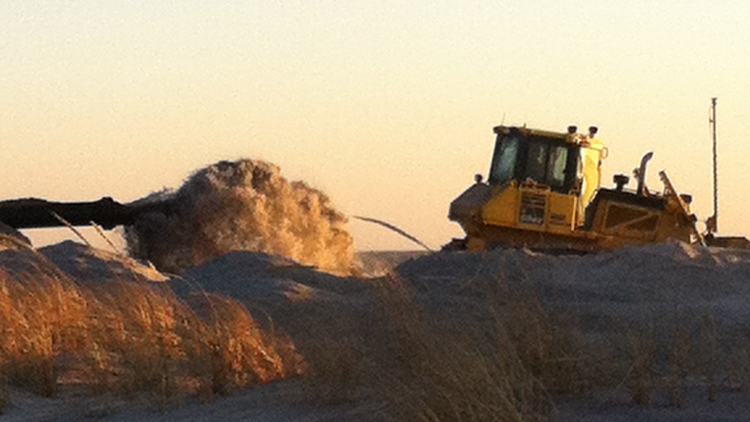Contractors are preparing to rebuild Sandy-flattened dunes on either end of Fire Island in time for summer, but communities in the barrier beach’s middle will remain vulnerable for a third hurricane season.
Illinois-based Great Lakes Dredge & Dock Corporation was awarded last month a $23-million contract to pump in 1 million cubic yards of the sand and rebuild 13-foot dunes from Robert Moses State Park in front of the Fire Island Lighthouse to the island’s westernmost hamlet, Kismet. Last fall, Dutra Dredging won a nearly $48-million contract to do similar work at Smith Point County Park on the island’s east end. Negotiations have yet to begin with the 41 property owners in the way of a new 15-foot dune planned for the third leg of the project—meaning that work wouldn’t begin until next fall, at the earliest.
“We have just about all the surveys done,” Suffolk County Department of Public Works Commissioner Gil Anderson said of planning the third leg of the project, which he estimated may not start for another two years.
The overall work is a part of a $207-million job known as the Fire Island Inlet to Moriches Inlet Stabilization Project, an interim plan meant to sure up FI with 7 million cubic yards of sand. That’s part of the $700-million Fire Island Inlet to Montauk Point (FIMP) storm mitigation project slated to finally start a half century after being proposed. The larger 83-mile project and the first chunk dedicated to the 32-mile barrier island are funded by Sandy aid.
FI, the largest of four barrier islands protecting the South Shore of Long Island from the Atlantic Ocean, was severely eroded during the October 2012 superstorm.
The U.S. Army Corps of Engineers awarded the first two beach-rebuilding contracts after the work was initially stalled when the Audubon Society sued to block the project on the grounds that it would harm the habitat of endangered piping plovers that live on FI. The Smith Point leg of the project includes about 100 acres of habitat enhancement for the birds.
But, a similar interim beach replenishment project planned for Montauk has been called into question again by Suffolk County Legis. Al Krupski (D-Cutchogue), who represents the North Fork and was the only lawmaker to vote against that plan.
“This is a project that one, is sure to fail and cause accelerated erosion to adjacent properties, and two, puts the maintenance on the shoulders of the taxpayers of the entire county,” Krupski wrote in a letter to Gil Anderson, the county’s public works commissioner.
Krupski took issue with the Montauk leg of the interim project that uses geo-tubes—giant sand-filled bags that would be buried in the makeshift dune—and the fact that county taxpayers would be billed for half of the repair cost for beach damage after future storms until FIMP is finalized.
Chris Gardner, a spokesman for the Army Corps, said a contract has yet to be awarded on the Montauk plan. Work on the east end of Fire Island is underway and the company tasked with replenishing the west end will begin in the coming weeks, he said. Both of those phases have a deadline of mid-April, when piping plover mating season begins.
Once the soon-to-be completed surveys are completed in the third leg of the project, property owners will be contacted by Suffolk officials who will send documents requesting easements for most oceanfront property owners. Options for the 41—mostly in Ocean Bay Park and Davis Park—that are in the way of the new dune include relocating their structures away from the dune, taking a buyout or condemnation.
A public hearing on the plan is scheduled for 6 p.m. Feb. 17 at the Van Nostrand Theatre at Suffolk County Community College in Brentwood.































